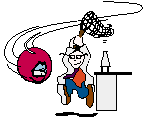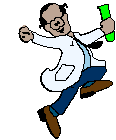Environmental Health Sciences
National Institutes of Health (NIH)
Department of Health and Human Services (DHHS)


NIEHS Kids' Pages Index
Links Disclaimer
| National Institute of Environmental Health Sciences National Institutes of Health (NIH) Department of Health and Human Services (DHHS) 
|
 NIEHS Kids' Pages Index Links Disclaimer |
Health and Science Careers...
|

|
|
Wearing a Lab Coat to Work
Why Study Environmental Health? |
Other Resources |

|
Getting Your Own Lab Coat!Careers for you in Science and Research!by Dick Sloane, NIEHS |
Are you curious? Do you like numbers? Do you like adventures? If so, maybe you should become a scientist! A good scientist is curious and asks lots of questions, such as:
Scientists seek answers to these and other questions. The answers help solve problems in our world. If you like numbers, science can be for you too, since scientists make many measurements. Things like length, weight, time, and volume are measured frequently. Numbers are recorded in a book called a "log book" or "record book," and usually are stored and analyzed with the help of a computer. So it's good to like working with a computer too!
Movie heroes like Indiana Jones live lives of high adventure. Scientists experience adventure too, especially when new information is discovered which might explain how something works, or even help cure people of a killing disease. Consider some of the discoveries of science: X-rays; vaccines for dangerous diseases; antibiotics; rocket engines; the transistor; and more recently, a gene which is responsible for breast cancer in humans, discovered by scientists at NIEHS. The scientists and their teams who made these discoveries sense excitement, adventure, and satisfaction because they are understanding how something works for the first time, and maybe solving a serious problem too. These discoveries can also be fun!
Some scientists specialize in studying living things. We call them biologists. Some try to learn more about the ground and the earth. They're called geologists. Physicists are scientists who study physical phenomena such as light or electricity. At the National Institute of Environmental Health Sciences in the Research Triangle Park in North Carolina, dozens of dedicated toxicologists study the effects of different chemicals on living things. A toxicologist is a specialized type of biologist who investigates chemicals to see if they act as toxins (poisons). These are just a few examples of the many kinds of scientists that make discoveries every day which make life better for all of us. We become healthier, with a better understanding of our world and the other animals and plants that live here with us.
Finally, a good scientist needs to communicate with other scientists through speech and in writing. That means solid skills in English are necessary. Though not easy for many of us, these skills come with time and practice. They'll come to you too and you'll find lots of help from your teachers, advisors, and even other scientists.
| Our world needs dedicated science professionals. Maybe you will become one of them! Keep reading (below) to learn more about how important and exciting a career in environmental health research can be! | 
|
Have you ever seen or heard stories about people having breathing problems from "air pollution," or about children getting sick after being exposed to paint with lead in it or other chemicals? Our environment (everything around us) has a big impact on our health and well being! That is why the National Institute of Environmental Health Sciences (NIEHS) and the National Toxicology Program (NTP -- located at NIEHS) study the health effects of the environment! Most health regulations result from studies that scientists at NIEHS, NTP, and other research organizations performed in an effort to determine which things in our environment might make us sick.
For example, although the fact that smoking causes cancer may seem obvious today, for years scientists had to do research studies to compare smokers with non-smokers in order to rule out many other things that people might have been around that could have also caused the cancer. Based on the results of those studies, people can be warned of the dangers of smoking, and decisions can be made as to whether or not to "regulate" the sale of cigarettes! (Learn About the Dangers of Smoking from
Mama Didn't Know
and
Smokefree Kids
. ) This is also the way scientists found out that exercise reduces the risk of heart attacks. And there are many, many more things we know today because of the efforts of research scientists.
But as valuable as it is, environmental health research studies have limits. Since diseases such as cancer may not show up in our bodies for many years, people may be exposed for several generations before a problem is spotted. So another important research method is the testing of substances in animals. Those studies provide us with much faster answers since mice and rats usually react to exposures in only two years or so, instead of the thirty or forty years that it might take for health problems to appear in people. We can frequently check the mice for signs of disease and use that information to decide much more quickly if there is a risk to humans. Some people don't believe that their bodies are enough like those of mice and rats to be hurt by the same materials. But we are very much like mice "genetically." In fact, most substances known to cause cancer in mice and rats -- like asbestos (an insulating material we used to use in houses and schools), benzene (an industrial cleaner), and radon (the earth's radioactive gas) -- also cause cancer in people.
Even though the old methods work, our research methods are always being improved. At NIEHS, we are always working on new types of studies that use fewer animals and take less time and money to perform. In addition, NIEHS scientists are working on ways to help predict the harmful effects of chemicals using cell cultures, microorganisms, some types of small fish, and mathematical and computer models. By combining the old techniques with the new, scientists can find out more quickly how things we are exposed to in our environment can result in sickness. Once we know where the dangers might be, we can reduce the number of diseases and deaths and help prevent people from being exposed.
| Privacy and Accessibility, Disclaimers and Copy Requests |
NIEHS Kids' Pages Home NIEHS Home |
| Links Disclaimer and Caution |
|---|
When you encounter this image  or the words "Non-NIEHS Link", it means that by following that link you will be leaving the NIEHS website. NIEHS is NOT responsible for non-NIEHS websites. Sites maintained by outside organizations may be changed without notice to NIEHS. Therefore, unless the link is to another U.S. government sponsored webpage, endorsement by NIEHS is not implied, and NIEHS does not guarantee their continuing safe content or privacy policies. So please ask your parent or guardian before continuing to any non-NIEHS website, and especially before providing any information via the internet or by e-mail. When last reviewed, the websites linked from the NIEHS Kids' Pages seemed suitable for you to visit, but that may have changed; if you have any difficulties or concerns with any linked materials, please let us know. or the words "Non-NIEHS Link", it means that by following that link you will be leaving the NIEHS website. NIEHS is NOT responsible for non-NIEHS websites. Sites maintained by outside organizations may be changed without notice to NIEHS. Therefore, unless the link is to another U.S. government sponsored webpage, endorsement by NIEHS is not implied, and NIEHS does not guarantee their continuing safe content or privacy policies. So please ask your parent or guardian before continuing to any non-NIEHS website, and especially before providing any information via the internet or by e-mail. When last reviewed, the websites linked from the NIEHS Kids' Pages seemed suitable for you to visit, but that may have changed; if you have any difficulties or concerns with any linked materials, please let us know. |